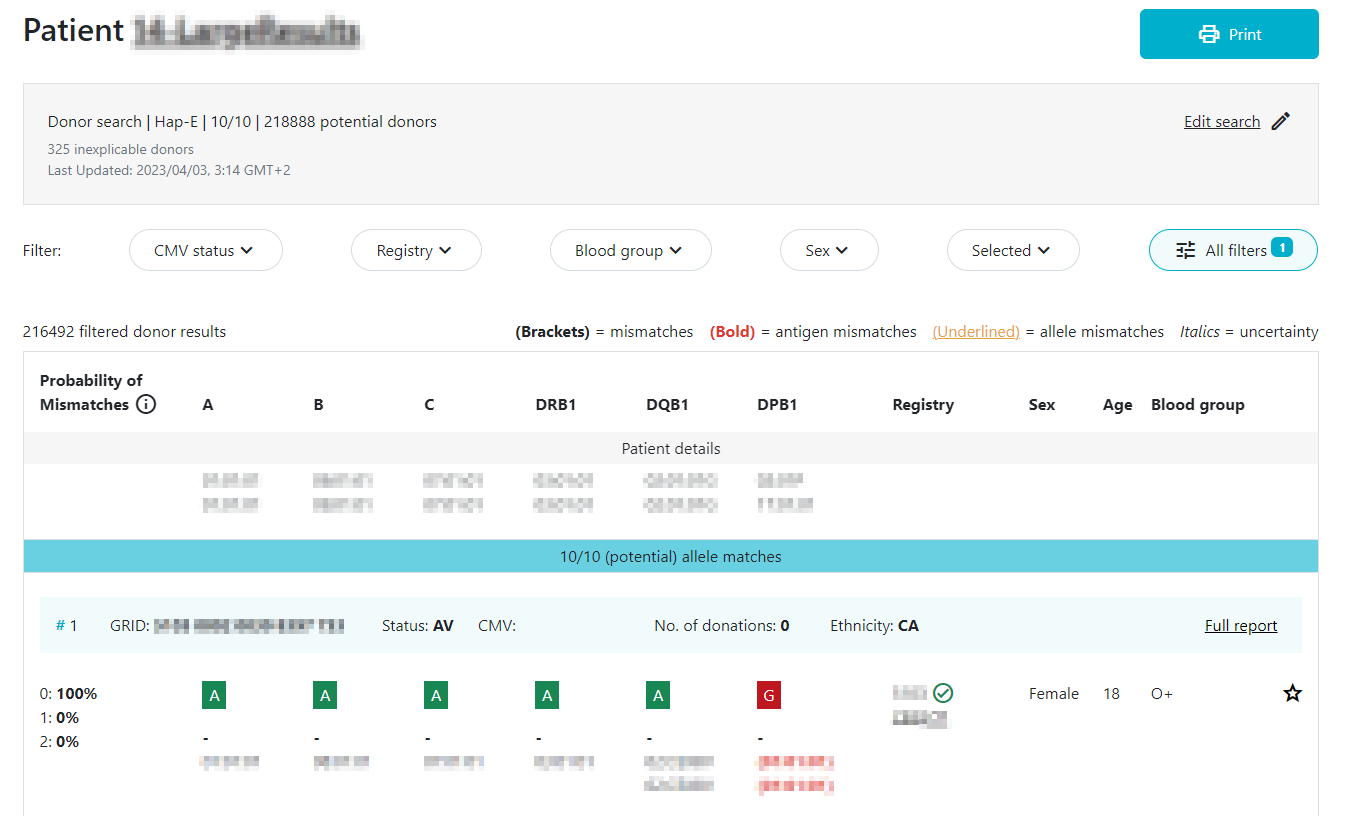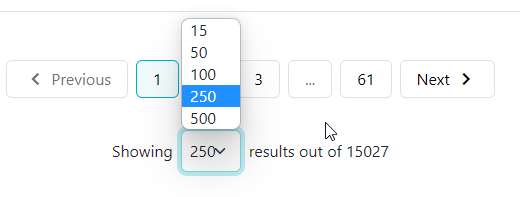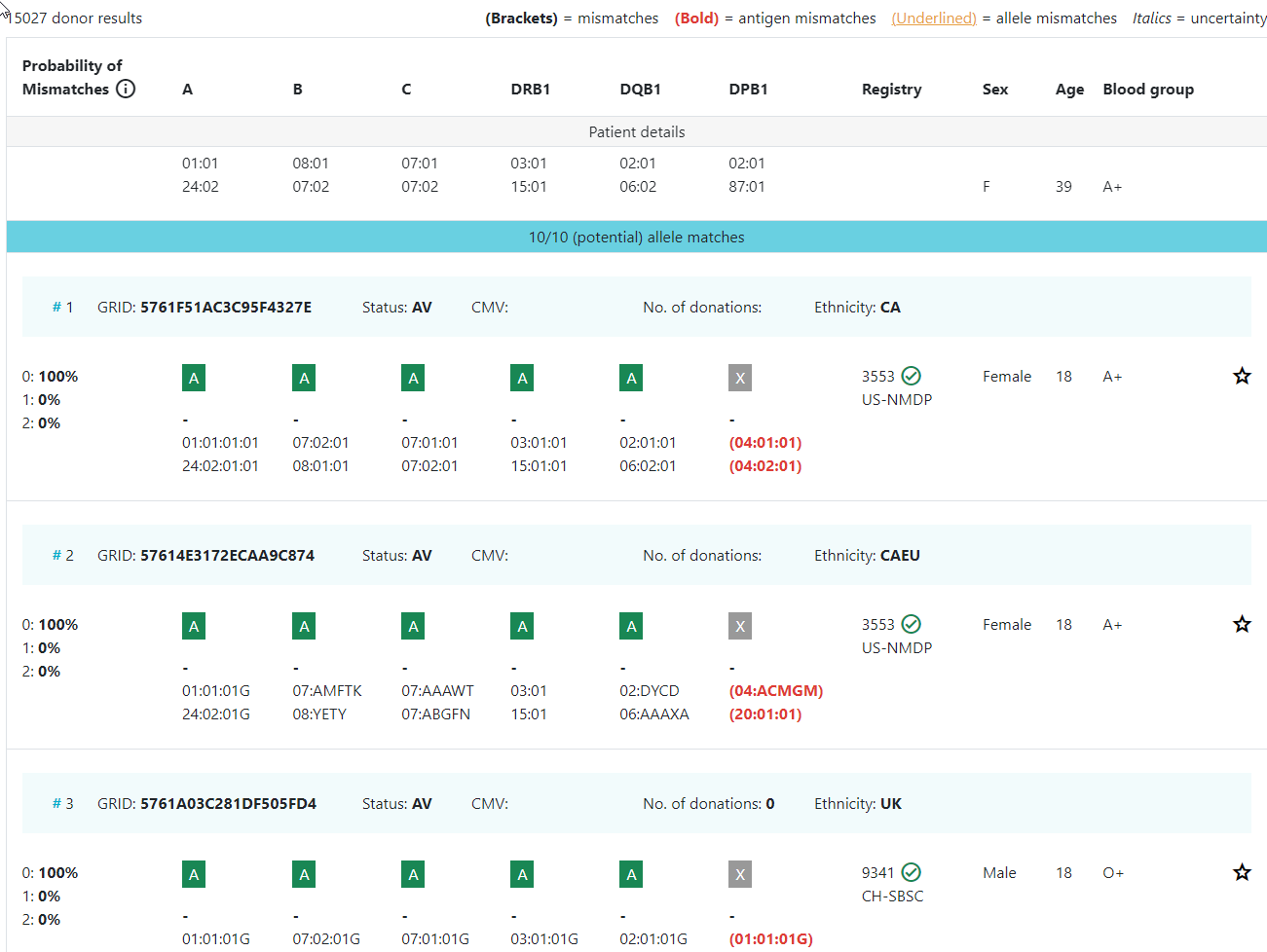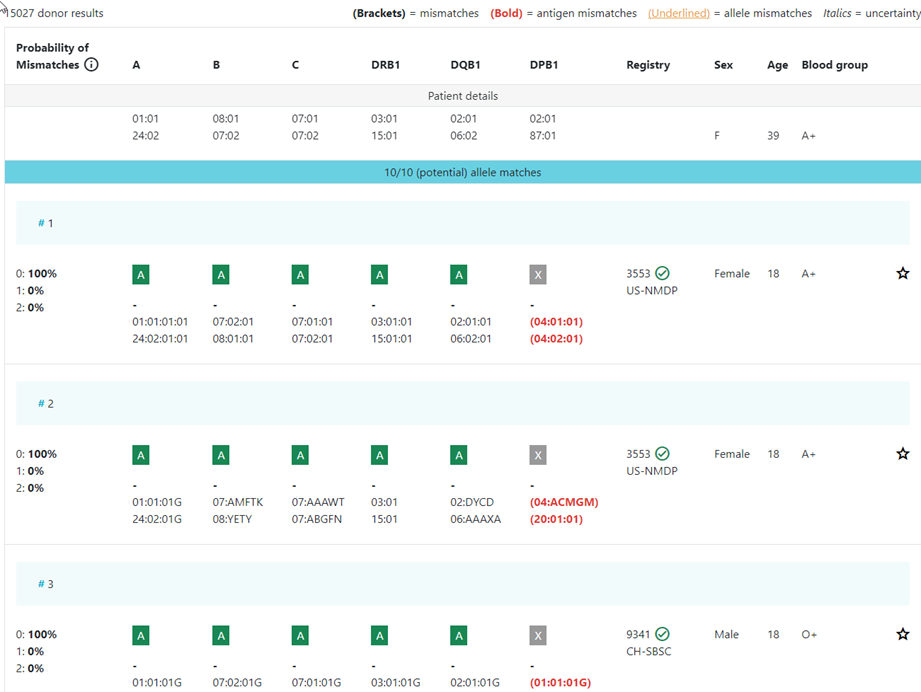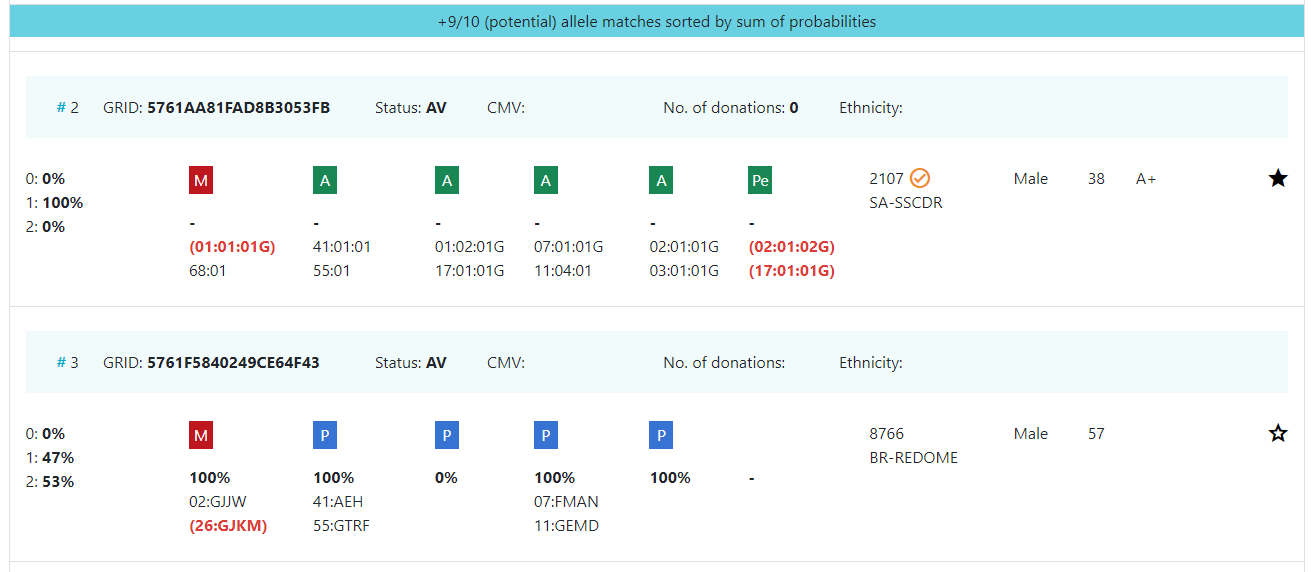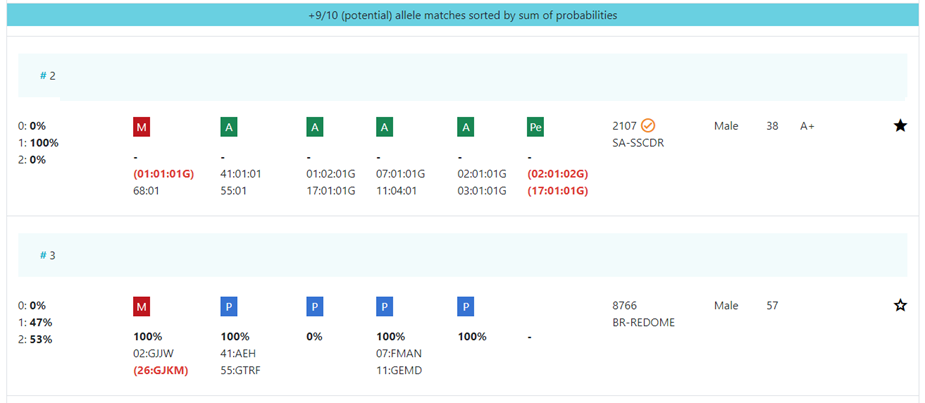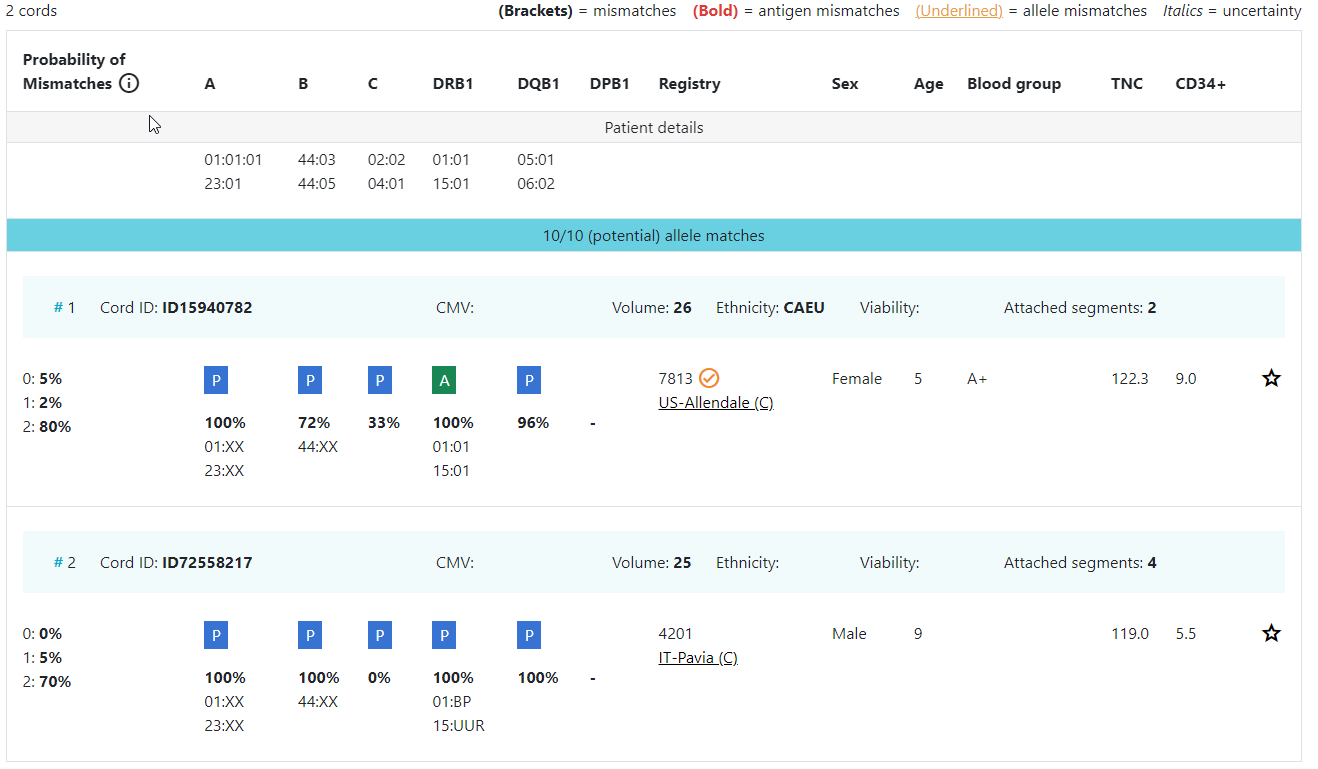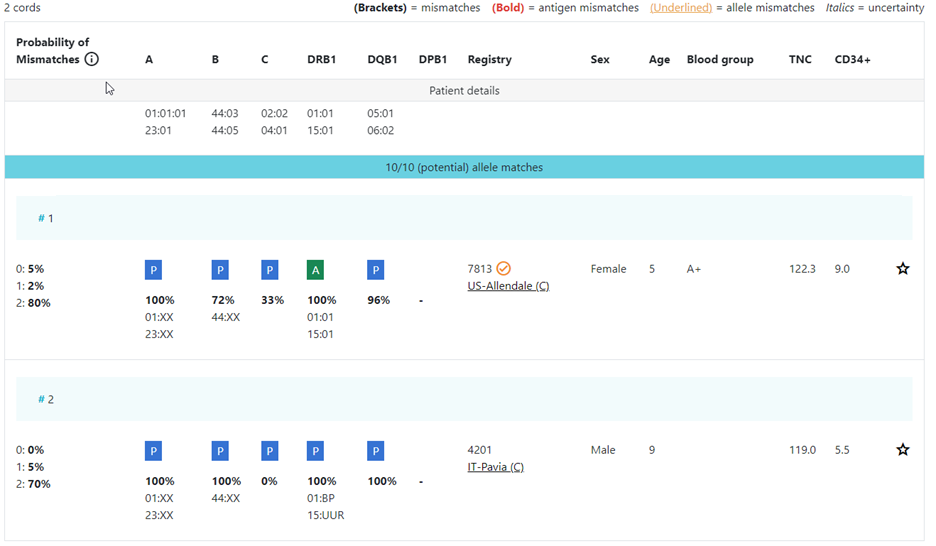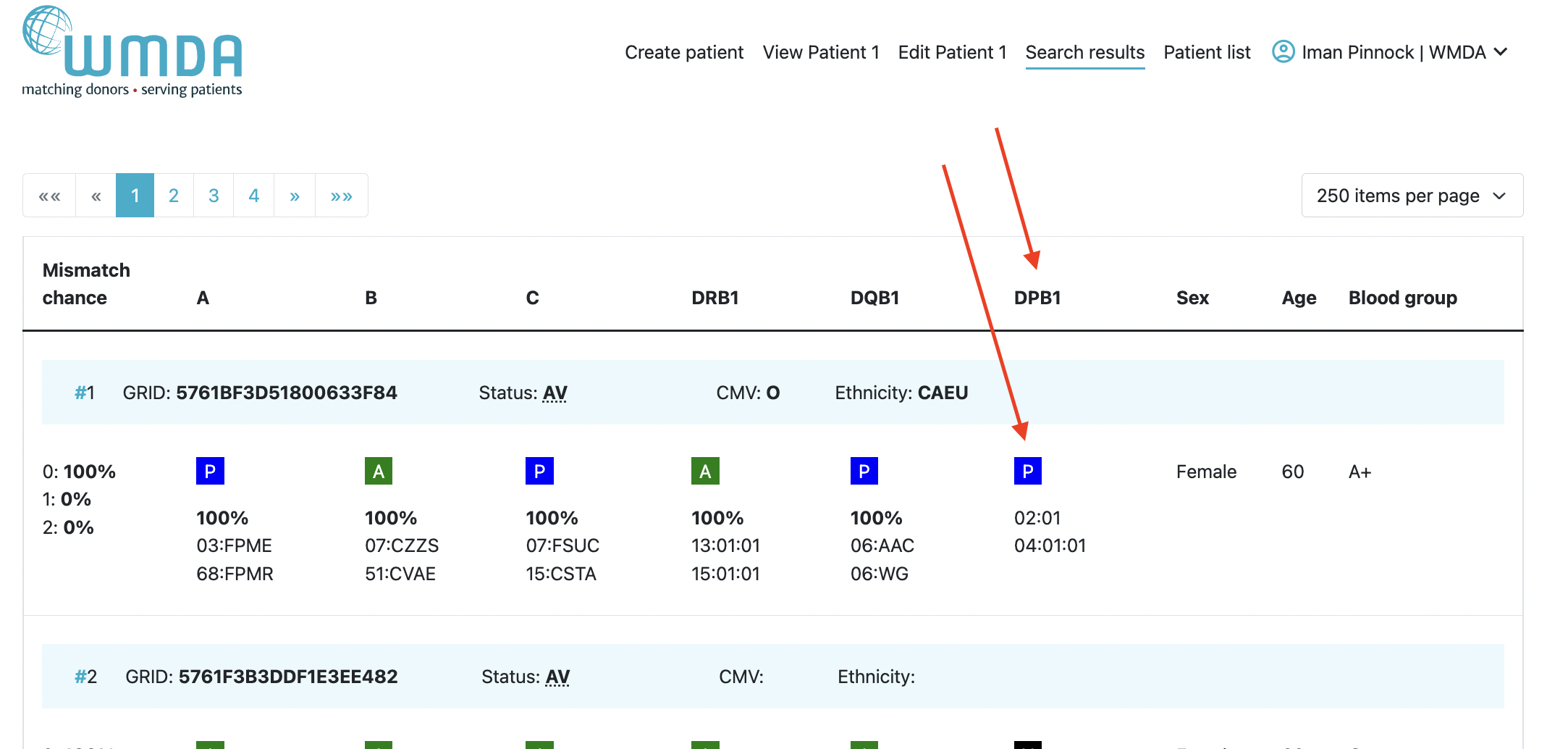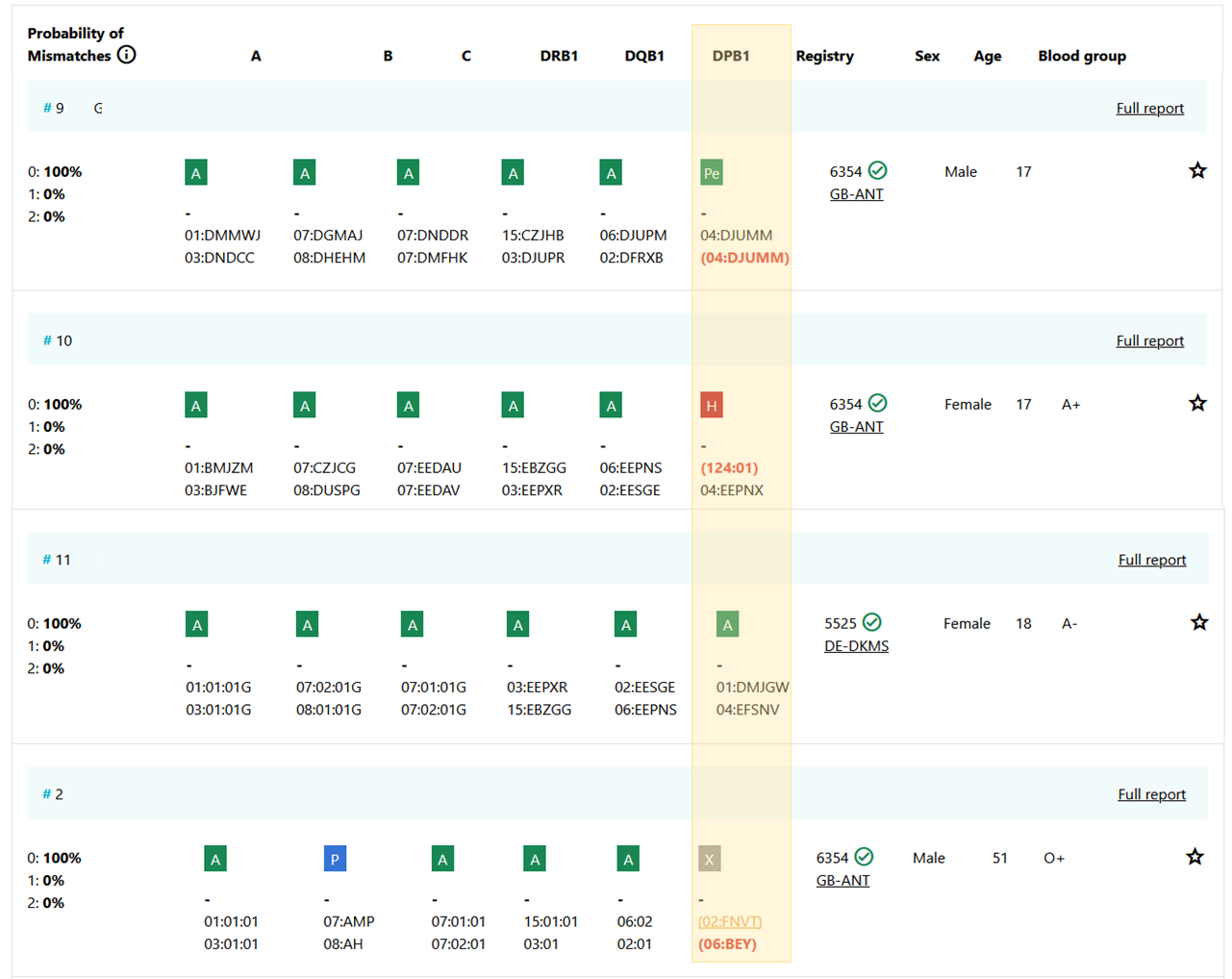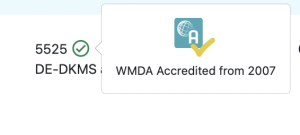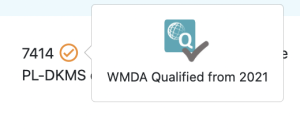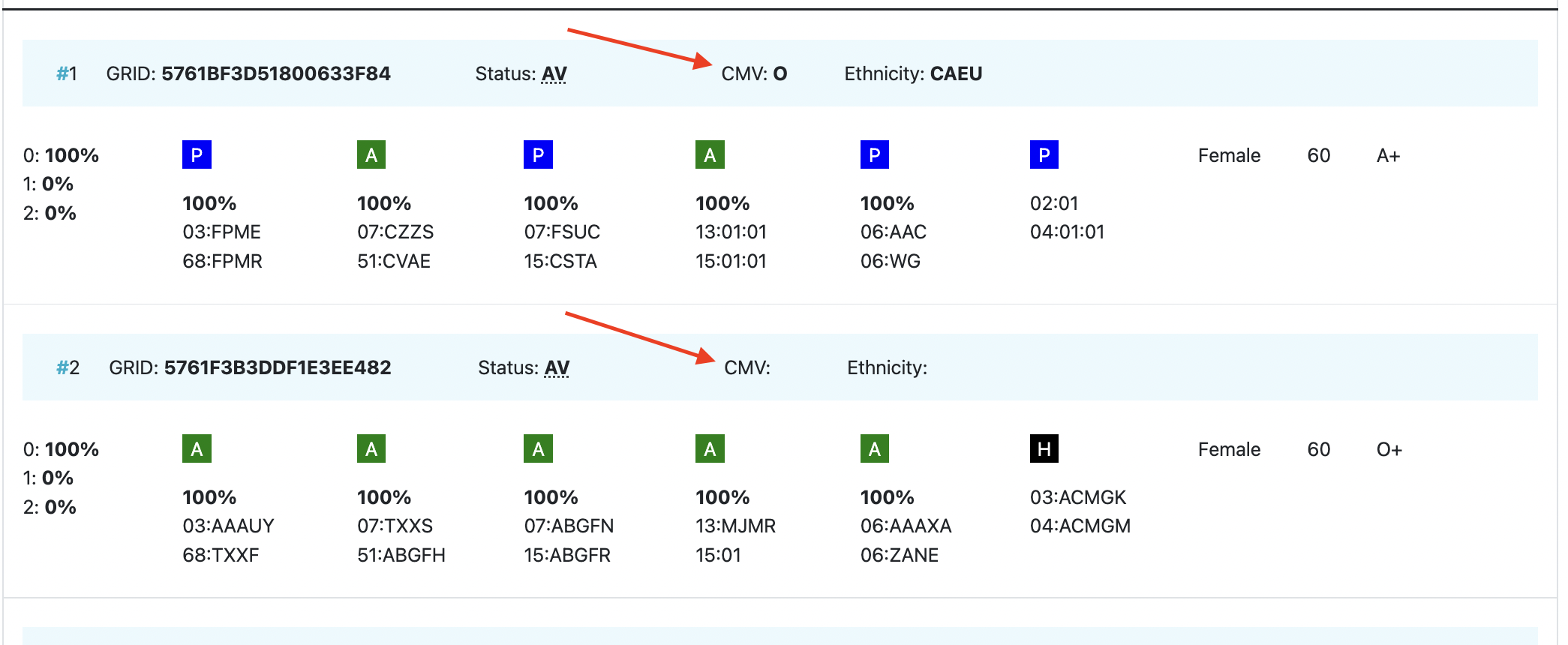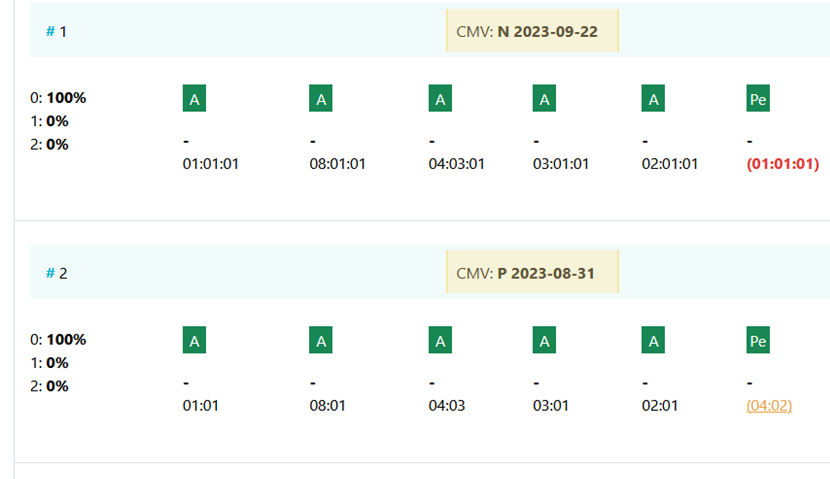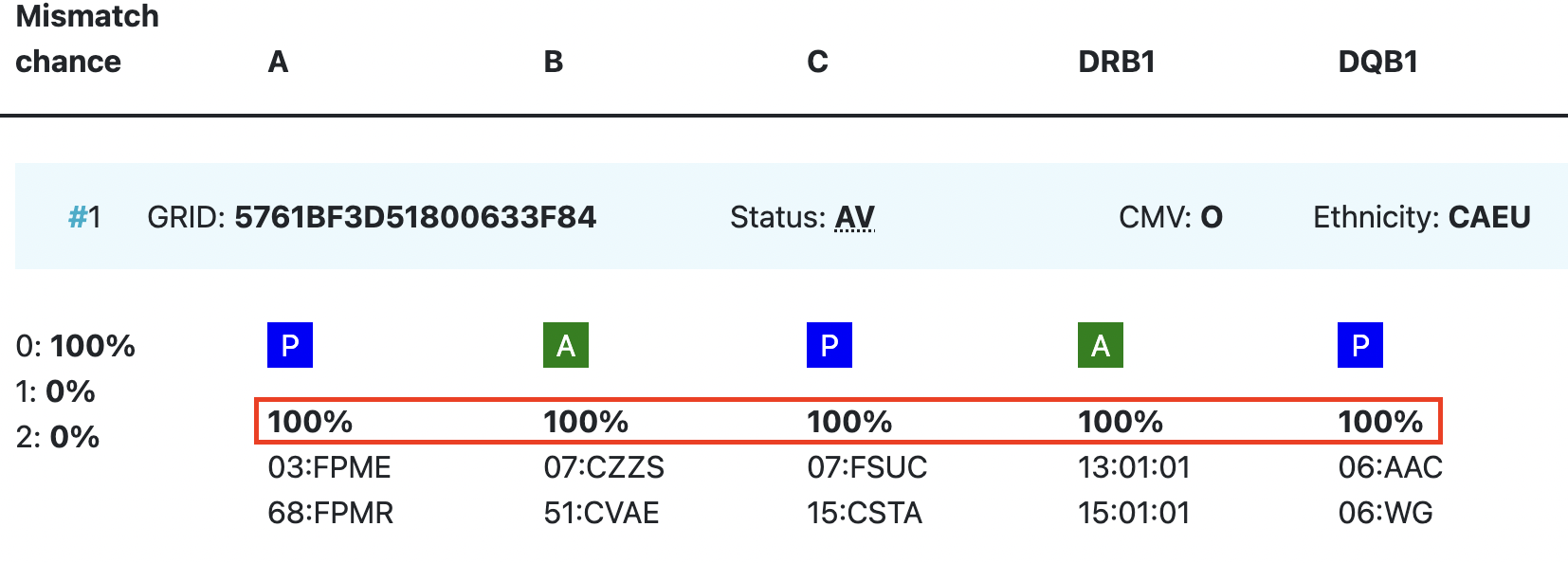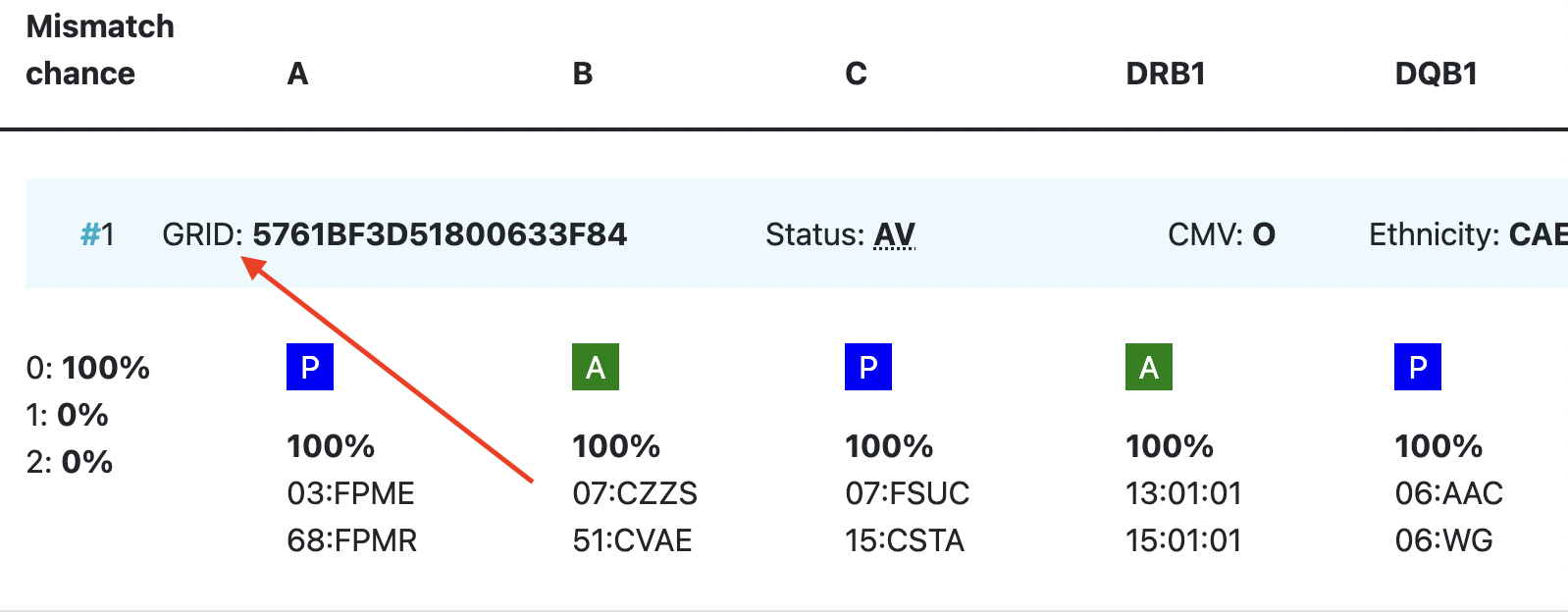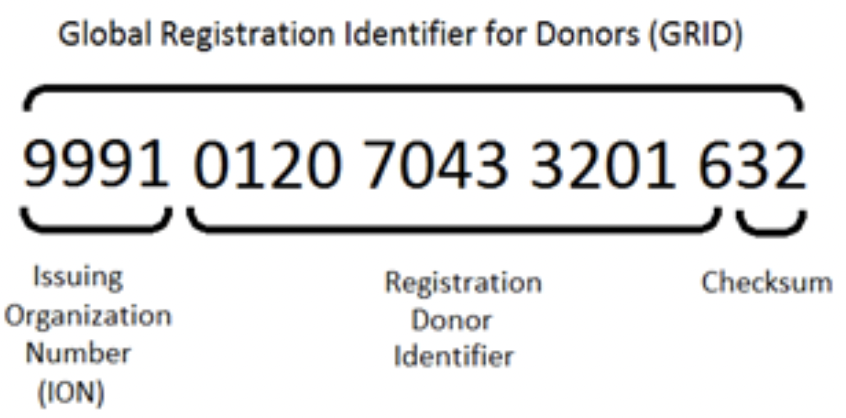...
- Patient ID
- Summary of search settings used
- Type of search
- Matching engine used
- Loci considered and number of mismatches allowed
- Number of inexplicable donors
- Frequently used filters
- Search results
| Imagefloat | ||
|---|---|---|
| ||
| Include Page | ||||
|---|---|---|---|---|
|
...
Actions | Description | |||||
Change maximum number of records displayed | The system by default shows you 250 search results. You can expand this to 500 records or reduce it to 15, 50 or 100 records per page. You can do this on the bottom of the search results page.
|
...
Overview of donor search match results
| Imagefloat | ||
|---|---|---|
| ||
| Imagefloat | ||
|---|---|---|
| ||
Explanation of colours, abbreviations, percentages and codes
Abbreviation / column | Description |
| HLA patient | In between two grey bars, in a white space, you can find the HLA of your patient. This sticky header will move with you when you are looking at results more below. |
Probability of mismatches 0, 1, 2 | Probability of a mismatch at 0 loci, 1 locus, and 2 loci. The percentages are based on the match type you have been chosen (out of 6 then 3 loci are considered; out of 10 then 5 loci are considered). The five squares above the probability percentages are representing, respectively, locus A, B, C, DRB1, and DQB1. They are showing in letter/colour codes if a certain locus of a donor/cord is likely to match with your patient or not.
|
| DPB1 TCE3 grading model | The sixth square indicates the DPB1 match grade. DPB1 TCE3 evaluation is performed and displayed for potential donors under the following conditions:
The results of the DPB1 TCE3 grading is shown below the donor’s DPB1 values by using the following symbols above the DPB1 alleles of the donor:
The explanation of the symbols is also provided when hovering the symbols.
|
Registry Reg Abbr | This column shows you the ION code of the registry or cord blood bank where the donor or cord is registered followed by the abbreviated name. This column may also shows you an icon that indicates that the registry is either WMDA accredited or WMDA qualified. If no icon is present next to the ION code, then the registry is not WMDA qualified or accredited. : the icon that indicates that the registry has a "WMDA accredited" or "WMDA qualified" status When you hover over the icon, the icon indicates whether the registry has been WMDA qualified or whether the registry has been fully accredited. Also the validity period of the qualification/accreditation is visible. The orange ticks have verification WMDA Qualified : The orange ticks have the icon with a "Q" and a silver/grey V: WMDA Qualified :The green ticks have the icon with an "A" and a gold/yellow V: WMDA Accredited : registry is accredited from 2007. : registry is qualified from 2021. |
Age | Current age of donor (in case of donor search)/ Time since cryopreservation of cord blood unit (in case of cord search) |
Gender | Sex: M = male, F = female |
Blood group | Blood group, e.g. A+ = blood group A, rhesus positive, B- = blood group B, rhesus negative |
CMV | CMV status Possible values: As seen in the second entry, a A value for the CMV status may not always be available. NOTE: A tooltip for information on the values can be used to aid in understanding their meaning. |
| Probability of match per locus | Within the donor/ cord details, the probability of a match per locus is displayed: This also correspondents with the match grade that is indicated by the letter/colour code from the five squares in the column probability of mismatchesabove the column with the match probability per locus. These probabilities are only are only calculated for the 5 loci A, B, C, DRB1, and DQB1. For more information on the differences between Hap-E and Optimas the matching engines please see the chapter below called "Differences between chapters: "Features Hap-E and Optimas regarding locus specific match probabilities"ATLAS" and "Feature comparison Matching engines". |
| GRID | GRID, Global Registration Identifier for Donors, is an ID for donors (not for CBUs) that is globally unique. The number is split into 3 sections;
Once a GRID is assigned it cannot and will not be reassigned - it is completely unique. For more information on the GRID number please refer to Global Registration Identifier for Donors - WMDA. |
Ethnicity | Ethnic group: The system uses the same ethnic groups as defined for the EMDIS system: The ethnic groups are as follows; |
| Status | Status of a donor or CBU. For donors, the status can be available (AV), reserved for a patient (RS), temporarily unavailable (TU) |
How to print search results or store as PDF
...
How to refresh search results for a patient
Automatically
...
Manual full refresh
...
: | |
| Status | Status of a donor or CBU. For donors, the status can be available (AV), reserved for a patient (RS), or temporarily unavailable (TU) |
How to print search results or store as PDF
| Include Page | ||||
|---|---|---|---|---|
|
How to refresh search results for a patient
Automatically
| Include Page | ||||
|---|---|---|---|---|
|
Manual full refresh
| Include Page | ||||
|---|---|---|---|---|
|
How to assign a user to a patient
| Include Page | ||||
|---|---|---|---|---|
|
How to deactivate a patient
| Include Page | ||||
|---|---|---|---|---|
|
How to change the activate a patient again
| Include Page | ||||
|---|---|---|---|---|
|
Differences between Hap-E, ATLAS and Optimas regarding locus specific match probabilities
For more information on the differences between the matching engines please see the chapters: "Features Hap-E and ATLAS" and "Feature comparison Matching engines", or please see the following slides and video.
Links to assist you in your searches
The following list contains useful links to assist in finding a potentially matched donor:
- WHO HLA Nomenclature
- Immuno Polymorphism Database (IMGT/HLA)
- Allele Frequencies in worldwide populations
- Bioinformatics and HLA expertise
- HLA Frequency Maps
- The Common and Well-Documented (CWD) allele catalogue 3.0.0
- Be the Match Haplostats
International professional organisations
In the field of HLA a few professional organisations are active in order to provide information on immunogenetics and histocompatibility.
- World Marrow Donor Association (WMDA)
- Worldwide Network for Blood and Marrow Transplantation (WBMT)
- American Society for Histocompatibility and Immunogenetics (ASHI)
- European Federation For Immunogenetics (EFI)
- British Society for Histocompatibility and Immunogenetics (BSHI)
- European Society for Blood and Marrow transplantation (EBMT)
- Center for International Blood and Marrow Transplant Research (CIBMTR)
- American Cancer Society (ACS)
- American Society for Transplantation and Cellular Therapy (ASTCT)
- International Society for Experimental Hematology (ISEH)
FAQ from Users of the Search & Match Service
...
How to assign a user to a patient
...
How to deactivate a patient
...
How to change the activate a patient again
...
Differences between Hap-E and Optimas regarding locus specific match probabilities
There is a difference in the meaning of the indicated probabilities per locus between Optimas and Hap-E. For more info on this please see the following slides and video.
Links to assist you in your searches
The following list contains useful links to assist in finding a potentially matched donor:
- WHO HLA Nomenclature
- Immuno Polymorphism Database (IMGT/HLA)
- Allele Frequencies in worldwide populations
- Bioinformatics and HLA expertise
- HLA Frequency Maps
- The Common and Well-Documented (CWD) allele catalogue 3.0.0
- Be the Match Haplostats
International professional organisations
In the field of HLA a few professional organisations are active in order to provide information on immunogenetics and histocompatibility.
- World Marrow Donor Association (WMDA)
- Worldwide Network for Blood and Marrow Transplantation (WBMT)
- American Society for Histocompatibility and Immunogenetics (ASHI)
- European Federation For Immunogenetics (EFI)
- British Society for Histocompatibility and Immunogenetics (BSHI)
- European Society for Blood and Marrow transplantation (EBMT)
- Center for International Blood and Marrow Transplant Research (CIBMTR)
- American Cancer Society (ACS)
- American Society for Transplantation and Cellular Therapy (ASTCT)
- International Society for Experimental Hematology (ISEH)
FAQ from Users of the Search & Match Service
...
Updated due to last release of 2017-10-13
...
